 INTRODUCTION
INTRODUCTION
Unsafe abortion persists as a public health issue in Nepal, despite increased access to legal and safe services since 2002. While the number of authorized providers has grown and medical abortion options have expanded, many women still resort to unsafe procedures. Complications account for about seven percent of pregnancy-related deaths in Nepal. Challenges on the demand side include limited awareness of legal abortion, persistent stigma, cultural and religious influences, reliance on unauthorized pharmacy outlets, and socioeconomic factors. Unsafe abortions are more prevalent in countries with restrictive laws, inadequate services, and persistent stigma. This study aims to explore the complex determinants of unsafe abortion in Nepal, using quantitative and qualitative research approaches to examine barriers and facilitators to safe abortion access.
Study objective
• To investigate determinants of and factors influencing unsafe abortion practices and access to services in Nepal.
METHODOLOGY
This research employed a cross-sectional study design to investigate sexual and reproductive health issues among women of reproductive age (WRA) in 30 municipalities across Nepal’s seven provinces. The study used a stratified sampling technique to ensure adequate representation of women from different age groups. Quantitative data was collected through face-to-face interviews using structured questionnaires, while qualitative data were obtained through semi-structured interviews with selected men, in-laws, women leaders/activists, traditional healers, and Female Community Health Volunteers (FCHVs).

